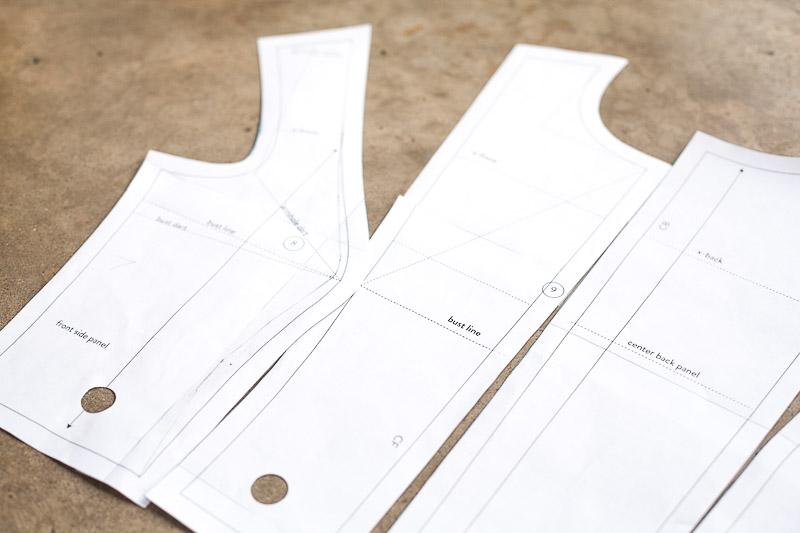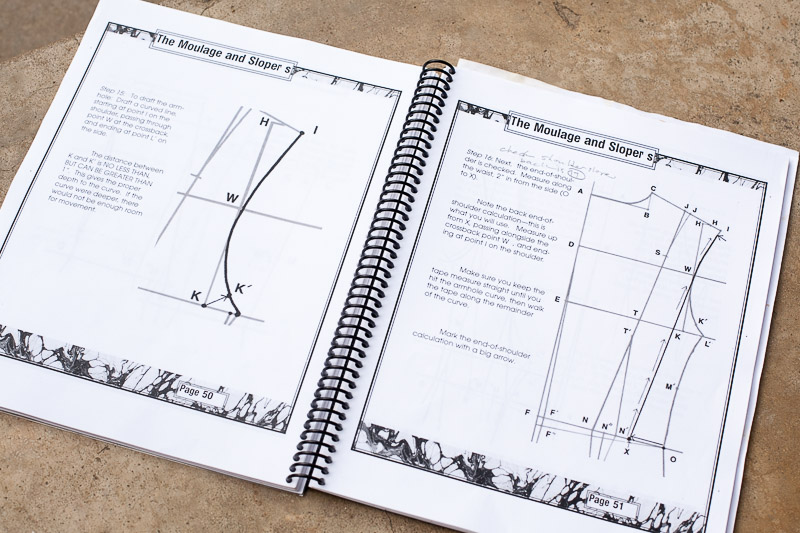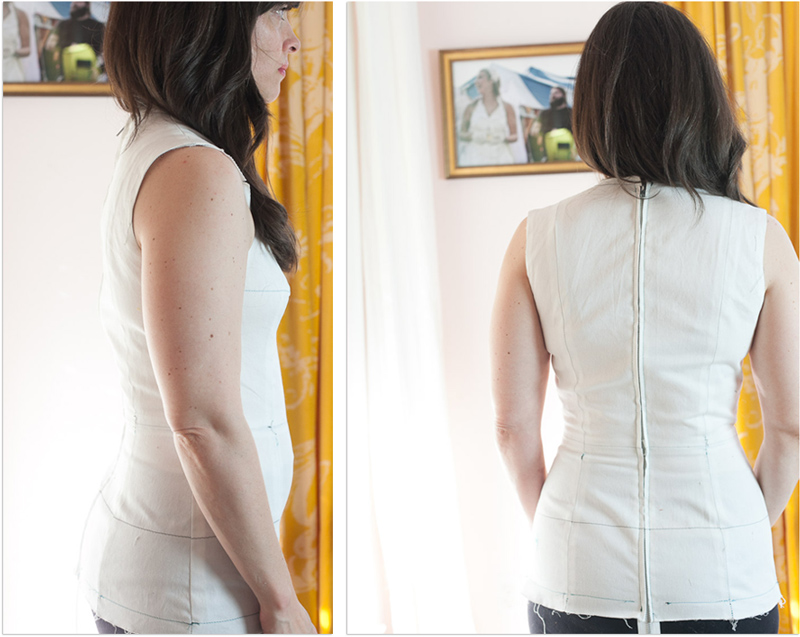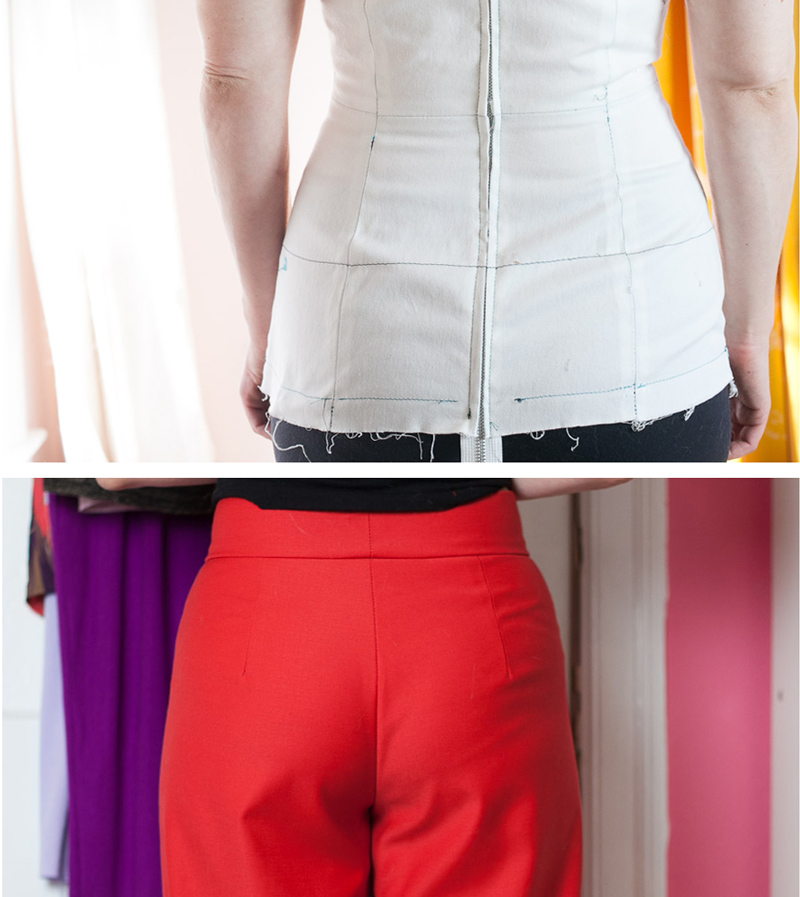
When I’m really craving a learning challenge I like to try out a new patternmaking method. It’s so much fun pulling out rulers (or in my case, Illustrator) and giving my analytical side something to circle around for a little while.
For my latest challenge I tackled a pattern fitting project I’ve been wanting to try for a few years–a moulage!
What’s a moulage, you ask? The term literally means “molding” or “casting”, and its use in garment making has origins in French couture. Sometimes “moulage” refers to an actual pattern, a skin-hugging hip length bodice that is fitted precisely to a person’s body. Often it refers to the whole process of manipulating fabric on a dress form as a method of developing women’s patterns and designs—aka draping or draping on the stand.
The art of moulage at Christian Dior:
Now you all want to go out and take draping courses, right?
So let’s turn back to the moulage as pattern. My favorite vintage patternmaking book, Dress Design: Flat Patternmaking & Draping, calls the moulage a “French lining pattern”. I suspect that it became known as a moulage precisely because it was connected with dress form draping. Couture houses have a long tradition of creating personalized dress forms that represent their wealthiest or most regular clients, and to get there, a form would be padded out to “map” a client’s body, thus quickening fitting times.
My goal in drafting one is exactly that–I’d like to pad out an older dress form to better replicate my body.
The Pattern

For my draft I pulled from my shelves Kenneth King’s book, The Moulage. He has been publishing this for several years as a CD book. Thankfully I printed it back when I first bought it because Macbooks no longer have CD slots!
If you are interested in other sources of moulage drafting, Suzy Furrer’s Craftsy course and her patternmaking book are places to learn. Her drafting method is nearly identical to Kenneth King’s; they learned from the same teacher and couturier. (The vintage book I mention above has a drafting method for a similar pattern but is not as thorough.)
In both Kenneth and Suzy’s methods, the moulage becomes a foundation for drafting a less fitted “sloper”, a bodice with a bit of ease, which then becomes the foundation for other garments. I don’t have a need for a bodice sloper, and if I didn’t already have one, there are other (easier) ways of drafting one without having to start with a moulage.
The Fitting
So how did mine turn out?
Drafting the moulage was actually the easy part. I had fun with it! The part that needs the most attention is measuring as it relies on a few really accurate points. Thankfully I had most of these measurements recently taken and just had to double check a few more.

This is my 2nd fitting. In my first try-on everything was surprisingly close but it all needed to be taken in at various points. Adjusting it all is actually fairly easy since there are so many seams. My pattern has 16 pieces in all, 8 in the front and 8 in the back.
With all these seams and lines it’s been helpful in seeing imbalances on my body. For instance my right shoulder is lower, which causes that diagonal wrinkle near the armpit and pushes a bit of excess fabric into the neckline:

And my right hip is slightly higher. You can see in these photos that after moving around a bit fabric tends to get hung up on my right hip. (The pants back is a photo from a fitting I did in the fall but illustrates the point!)

For these fittings, I used an inexpensive cotton twill that I found at Joann Fabrics. It was a perfect test fabric! Twill has a tighter weave than cotton muslin, which gives it a bit more shape and substance. (Muslin has a tendency to squish into the flesh a bit.) Any kind of tighter cotton woven, such as cotton twill or cotton drill, would fit more smoothly.
So where will I go from here? I’m going to tweak some of the remaining issues (a little too much length in back, uneven shoulder and hip), which means I’ll end up with separate right and left patterns. Might sound crazy to some, I know! If you happen to take the Craftsy course, students are often encouraged to move on to their slopers when they achieve “good enough”, since the moulage is just a starting point.
However, I’m going for as perfect as possible for my dress form. For my final version I’m using cotton coutil, a traditional corset fabric. It’s a an unusual choice for a dress form cover, but coutil has a really tight weave with a gorgeous smooth surface. I want a cover that will last a long time!
Have you ever tried a moulage? I’ll admit it’s kinda freaky looking at myself in a body envelope but I’m having so much fun with it!
Would you like tips and inspiration in the craft of lingerie sewing? Sign up for my weekly eletter The Lingerie Maker.

I love seeing the images of your moulage, especially since I’m in the process of making mine with Suzy Furrer’s Craftsy course. Thanks for the fabric recommendations! I’m really interested to see how you make up your dress form.
I’ll be sure to share when I get to that part!
I did the same thing too – ie a KK moulage that I then used to make a cover for my me-made dress form. My fitting was done with standard muslin and did suffer from more wrinkles than I’d care for. So good tip about using a sturdier fabric. My dress form cover was made with ticking that someone told me is used for corset & stuff.
Waisted Efforts – a guide to corset for costume designers – shows similar skin-tight bodice block, which the author calls a “French Block”.
BTW, did you added a waist seam? My KK Moulage only had the vertical seams. All the horizontal lines on my are just top-stitched guidelines. What was your reason for adding the waist seam?
Hi Pia, ticking seems like a really good solution, too. I think that coutil is similar in density. Mine has a really subtle herringbone weave and is just a little bit thicker than the twill I was using for fittings.
And yes, I did add a waist seam–good catch! The KK draft adds waist shaping in back but I wasn’t clear about what do with with this shaping. I needed the shaping in front and back, so my waist to hip is longer at the side seams, and the waist seam dips in CF and CB. This helps it to sit better, I think. (This is the way Suzy Furrer does it, too.) Maybe I can share a picture in a follow up post so you can see my pattern. 😉
And Waisted Efforts sounds like a great book to add to my collection! (I’m just beginning to dive into corset books.)
I’ve been trying to get my moulage done for about a year now and I’ve found Suzy’s craftsy class very good, but it’s been hard to measure and fit myself on my own so after two tries I’ve given up. I too have asymmetries that will require separate side pieces which complicates the process even more, but seeing how good yours is looking I’m inspired to try again!!
Hi Manouela, I know it’s a lot of work to do on your own! I actually tried a similar type of pattern over 10 years ago and had a hard time pushing ahead without further fitting experience. Whenever I get frustrated with a fitting project I put it aside for a long time. Sometimes fresh eyes are the best!
Also, getting the measurements on your own is the hardest part, especially the shoulder to apex and back length which change dramatically with posture. Do you have someone that can take those for you?
Keep at it!
I have been doing the craftsy class as well and have found it to be a terribly frustrating process. I have just finished my 12th! version of the moulage and think I am finally happy. I did go through to sloper on a couple of versions, but found I was not happy with the ensuing patterns. Fingers crossed this time.
I would much have preferred to get help fitting a bodice from somebody who knew what they were doing, but I don’t know of anybody near where I live.
The hardest parts for me were determining the best position for the waist seam (which on me, is not my narrowest point), finding the shoulder point and measuring the armscye.
I’m so jealous that your second version is such a good fit! I am curious as to why you don’t think you need a bodice sloper?? I am hoping to us mine to both draft patterns for myself and to alter patterns that I already own.
Hey Katherine, oh bummer, I’m so sorry it has been so frustrating! I’m surprised to hear that. I wish we lived close by because I know we’d enjoy some good ole pattern analysis!
So the waist seam: I ignored the instructions and put mine where my narrowest circumference is. I have tried so many methods of “determining waist” but I’m now of the mind that in drafting for women the true waist is the narrowest part. If the garment is close fitting or has stretch reduction, this is where the fabric always wants to settle, regardless of some other arbitrary point. I tied some elastic around my waist and then walked around till it settled. Mine is about 3 inches above my belly button–quite high! Whenever I’ve made something that tells me to precisely put the waist “1 inch above the belly button” or some other proportional measurement, things just don’t hang right.
Finding the shoulder point is a weird one. I think it’s right at the outside end of that shoulder bone tip but I need to shorten it in a bit–otherwise my armscye shape gets weird and the armscye starts cutting into my underarms. Most women seem to have shoulder lengths in between 10.5 to 11.5 cm, if that helps.
Also, I already have a bodice sloper! I drafted it a few years ago using another method so I don’t need another. Honestly, I never use it for anything but checking length measurements on other patterns. I have a few blocks I worked on that serve most of my needs (finally this year I got my dream two-piece sleeve!).
But if you ever want to talk more about fitting, definitely send me an email. I’d be happy to discuss my experience with the moulage ;).
I really loved this post. I have have some similar issues when ‘moulagimg'(?). I think your idea to use coutil is genius – it makes perfect sense! Good luck on your journey and keep us up to date.
Kimberly
Thanks Kimberly, ‘moulaging’ sounds just about right! I’ve been saying this word a lot around our house… it just sounds weird and fun.
Amy, good job on your moulage. It is an odd feeling to wear something so close fitting. I’ve been entertaining the idea of covering my dress form too. I look forward to seeing yours!
Thanks Michelle! It’s going to be a process but I’m really enjoying it and look forward to sharing more.
I’ve never been able to sew a fitting shell from my own patterns, and I think it’s because two factors:
1. It’s very difficult to measure yourself, so I enlisted my husband, my mom and my daughters and every time I get different measurements.
2. I’m petite and busty, so when I try to follow any pattern making book always have anomalies and strange calculations.
Conclusion: I’m frustrated!…..
Your moulage is fantastic! and the video is amazing!
Raquel, I’m so sorry you’re frustrated! And yes, it’s easy to get different measurements every time you measure. I measured my husband five times for his back length and every time I got radically different measurements (I couldn’t get him to stand still!).
One of the things experienced patternmakers and tailors are good at is assessing posture and overall body balance, and adapting a drafting method to those specifics. Even with perfect measurements, I don’t know of any pattern drafting method that turns out a perfect fit. (Every body has anomalies.) Learning to fit is another skill and that’s where beginning patternmakers get so frustrated ((including myself when I first started learning)!
I guess I’m saying all that to encourage you!–because it does get easier. I promise. Do you have any good fitting books? Most of the fitting books will help in fitting a basic bodice and if that is what you are trying to draft (a bodice sloper, it sounds like?) it might be helpful.
I’m way behind you guys, but this list was very interesting and inspiring for me thanks.
Thank you for this post. It and the video were and are amazing! TFS, Annette
I’ve been wanting to make a body sleeve for my dress form for a long time too, but just never get around to doing it. Yours looks gteat. And thanks for the links to different resources.
A sleeve form would be a really intense project!
very interesting! I think I prefer this method for making a body double over all others (duct tape/ foam/…) But maybe not the first thing you should try if you’ve never made a sloper or drafted a pattern before?
I was wondering if you wear a bra under the moulage? I think so but what to do if you wear different kind of bra’s? because patterninstructions often say to put on the bra you would wear underneath the blouse/dress
Riet, there are two very interesting classes on Craftsy that may help. One is called “Customize a Dress Form” and the other is the moulage drafting class I mention above. Both are really helpful for beginners. Drafting really isn’t that hard when you’re following a good teacher!
I wore the same bra every time I tried on the moulage just so I would get consistent fitting results. I picked one that I wear more often than others. So I would say wear the style of bra you wear most often. For example, if you wear padded bras a lot, wear a padded bra in fitting. Otherwise your moulage will have a smaller bust than the one you need on your dress form, if that makes sense!
This is what I want to do since ages, I think. I don’t have a dress form, buy simply having a true (asymmetric) sloper as base for things I make would be so useful. At least that’ what I imagine. 🙂
Hi! Nice post you have here 🙂 By the looks of it, creating a moulage is such a tedious process. I’ll try to make one after taking Suzy’s class in Craftsy. By the way, I was wondering what method you used to make a sloper. Thanks!
Hi Julianne,
It didn’t feel tedious to me ;). I love fitting and drafting, ha! In this post I wrote about what method I used (Kenneth King’s) and how it is very similar to the drafting method in the Craftsy class. Or were you asking how to get from moulage to sloper, which has some wearing ease? Both the book and class detail how to use this.
I am probably a bit unusual in that I only use this moulage as a measuring tool—I use it to measure other patterns for length and occasionally width alterations. I don’t use either the moulage or slopers to make patterns.
There are faster ways for me to make patterns, usually from blocks that I already have fitted over time from other patterns or from a book that has a specific block I want. For example the red trousers in the picture were drafted using a trouser draft in a German patternmaking book as a starting point. I didn’t make a “sloper” first, if that makes sense.
Thanks for your reply Amy 🙂
I think my question is incomplete.. my bad, hehe. I wanted to know what method you used for the sloper without creating the moulage first 😀 In Suzy’s class, it was a requirement to make the moulage first then convert it to a sloper.
Hi Julianne, your question definitely made sense. I apologize if my answer was confusing. I was saying in a roundabout way that I didn’t use a method to turn the moulage into a sloper because I didn’t need a sloper. I took the class because I *only* wanted to draft a moulage and use it as a dress form cover, not as a first step in creating patterns. There are certainly other ways to draft patterns that don’t involve starting with a moulage. A basic patternmaking book is a great place to start!
Hello!
I took a pattern drafting class 4-5 years ago and was unearthing my notes hoping to make a moulage, but discovered I’m missing a critical page of notes! I have the same spiral bound book by Kenneth King, but somehow am missing pages 31 & 32 which are the pages that would have the measurement calculations you need to start drafting. is there any chance you could email a picture of those pages? i dont want to have to buy a whole new book! 🙁 Thanks so much,
Kathleen
Hi Kathleen, that does stink! Unfortunately I don’t have a picture of those pages but perhaps you could write Kenneth directly and see if he could send them to you? http://www.kennethdking.com/book/
Awesome website you have here but I was curious about if you
knew of any community forums that cover the same topics discussed here?
I’d really like to be a part of community where I can get
responses from other knowledgeable individuals that share the
same interest. If you have any suggestions, please let me know.
Appreciate it!